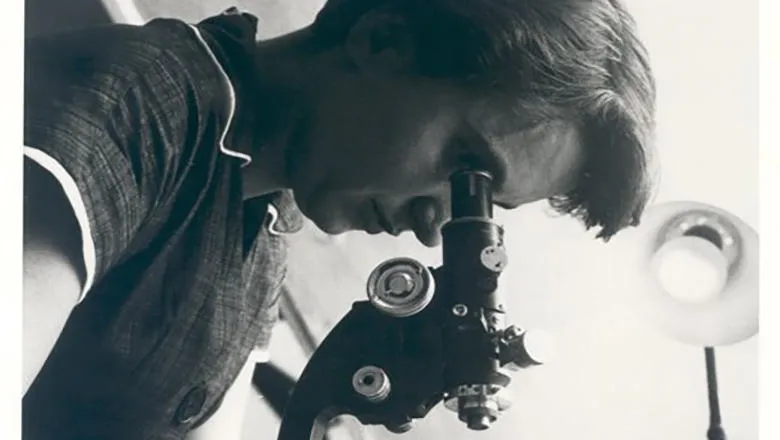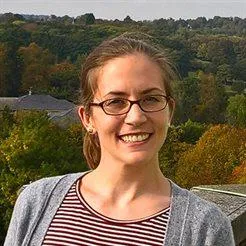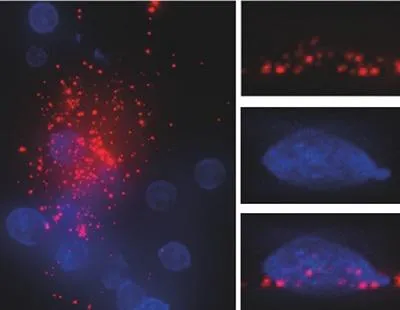02 April 2019
In the footsteps of Rosalind Franklin
King’s students will get the chance to follow in the footsteps of Rosalind Franklin and Maurice Wilkins when a new BSc/MSci Physics with Biophysics course launches in autumn 2019, bringing some of King’s rich history in the subject to its undergraduate physics programmes.

Biophysics is a field that applies the theories and methods from physics to the understanding of how biological systems work. World-changing biophysics work was done at King’s in the 1950s by Franklin and Wilkins, who made crucial contributions to the discovery of the structure of DNA, and King’s has been investing heavily in biophysics research and education in recent years.
We met with Dr Katelyn Spillane, Lecturer in Experimental Biophysics at King’s, to find out more.
Hi Katelyn, can you tell us more about the intersection of biology and physics and why it’s so exciting?
In the most general sense, biologists want to understand how biological systems work, and physicists want to discover the quantitative physical laws that describe how all of nature works. Biophysicists merge these two disciplines and so we use the theories and methods from physics and apply those to understanding biological systems. This involves the collection and interpretation of data, but also using these data to create models that will help us make better predictions for how biological systems function.
We’re at a time in the life sciences where we’re generating lot of data across a lot of different scales, from the atomic and molecular scale to the level of whole cells and tissues, all the way up to the level of organisms and even entire populations, To understand how complex biological processes emerge we need to understand how these molecular level interactions can build up to these more complex functions. For example, how the interaction between an individual virus particle with an individual receptor on a cell surface triggers an immune response throughout the whole body, and can potentially influence the spread of disease throughout a population.
What makes physicists so well equipped for working in this area?
These sorts of problems are really hard to solve, but they’re also the sorts of problems that physicists are really good at. Physicists are well equipped to develop the methods needed to test hypotheses, acquire and interpret data, and then use the data to build models that will help us come up with new hypotheses that we can test. We can then potentially make predictions about how complex biological systems will work. I think that if we can crack these problems and understand how these processes emerge over very different scales, then we can make some really important contributions to the life sciences.

What do you enjoy most about working in biophysics?
Biophysics is a really vibrant community that brings together scientists from across the physical sciences including physics, chemistry and engineering to work on problems in all areas of biology ranging from neuroscience to immunology to cancer biology.
What’s most fun for me is that there’s always something new to learn. There are new techniques being developed and new biological questions being identified all the time, which means I never get bored!
Can you tell us more about your route to working in biophysics? How did you first come to combine these two fields?
I hadn’t really planned to become a biophysicist because when I was an undergraduate student, I didn’t even know that biophysics was a thing. There were no biophysics classes available for me to take, let alone a biophysics degree programme. So I got my bachelor’s degree in chemistry and then went to graduate school for a PhD in physical chemistry.
Graduate school was my first introduction to the power of physics applied to biology, because I was using spectroscopy to understand how photoactive proteins interact with light, and specifically how they absorb light energy, store it, and then use it to drive biological functions.
As a postdoctoral researcher I used light in a different capacity - in the form of optical microscopy - to investigate how individual proteins move and interact with each other, and how these molecular level interactions lead to more complex behaviour. But I always felt a little bit limited because I wasn’t able to scale these sorts of experiments up to understanding something as complex as a living cell.
So how did you gain the skills and experience you needed to do that?
To get that side of it I had to actually go and work in a biology lab. I took a second postdoctoral position in an immunology lab, learning about how immune cells work, how they interact with their environment, and how they recognise potential threats to the body. While I was there I worked alongside biologists, learning about what the important biological problems are, and on the more practical side of things how actually to handle immune cells and use them in experiments.
Now in my own lab at King’s, we develop and use physical tools such as microscopy, nanotechnology, and materials to understand how immune cells function.

Our Physics with Biophysics students will be joining us in autumn 2019; what kinds of real-world problems can they look forward to working on when they graduate? And how will the course prepare them?
Biophysicists can work on many different problems across different sectors. You can discover new types of renewable energy sources, make new drug delivery systems, develop new therapeutic treatments. If we go back to our discussion of viruses, to take just one example, if you worked on understanding how molecular level interactions trigger an immune response, you could potentially develop new vaccine strategies to combat disease.
Biophysicists work as teachers and as researchers, they work in hospitals and in tech start-ups, all sorts of places. But a Physics with Biophysics degree course won’t just turn you into a biophysicist. It will teach you a wide range of transferable skills, such as analytical thinking and strong quantitative skills.It will also give you the ability to make connections across different complex disciplines to learn something new. These are all valuable skills that you can apply pretty much anywhere and to any sort of problem.
Read more about the King’s BSc and MSci Physics with Biophysics courses
